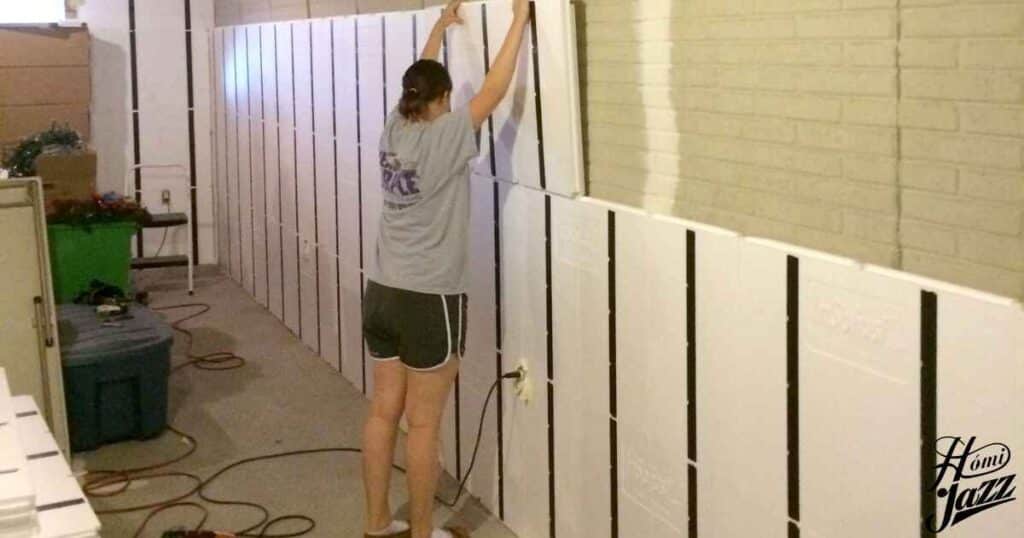Basement moisture problems can severely damage your home’s foundation and create unhealthy living conditions. Traditional drywall solutions often fail to address these issues, leading to mold growth, structural deterioration, and costly repairs. Basement wall panels offer a modern, effective solution to these persistent moisture challenges. This comprehensive guide explores the various types of basement wall panels, their installation processes, and key benefits. From waterproof PVC options to cost-effective alternatives, you’ll discover how these specialized panels protect your basement while creating usable living space. Learn the essential facts about materials, costs, and maintenance to make an informed decision for your basement renovation project.
Understanding Basement Wall Panels
Basement wall panels represent a significant advancement in home renovation technology since 2020. These specialized panels create finished basement spaces while protecting against common moisture issues. Modern basement panels combine durability with aesthetic appeal, transforming underground spaces into comfortable living areas.
What Are Basement Wall Panels?
Basement wall panels are engineered wall systems designed specifically for below-grade installations. These panels typically measure 1/2 inch to 2 inches thick and come in standard widths of 16 to 24 inches. The panels attach directly to basement walls using specialized mounting systems. Most panels feature built-in insulation and vapor barriers, eliminating the need for additional materials. Unlike traditional drywall, these panels resist water damage and prevent mold growth through their specialized composition.
Why Choose Wall Panels for Your Basement?
Modern basement wall panels offer superior moisture resistance compared to conventional materials. Recent studies from 2023 show that properly installed panels can last 25-50 years without degradation. These systems provide excellent insulation values, typically R-13 to R-21, reducing energy costs. Installation takes 50-70% less time than traditional finishing methods. The panels require minimal maintenance and can be cleaned with standard household products.
Common Basement Moisture Issues
The Environmental Protection Agency reports that 60% of U.S. homes experience basement moisture problems. These issues cost homeowners billions in repairs annually.
Understanding Basement Dampness
Basement dampness occurs through various mechanisms, including hydrostatic pressure, condensation, and seepage. Ground moisture consistently pushes against foundation walls, seeking entry points. Temperature differences between the basement and outside air create condensation on walls. Water table fluctuations, especially during spring months, increase moisture pressure against basement walls.
Signs of Basement Moisture Problems
Early detection of moisture issues prevents costly damage. Common indicators include:
Table: Warning Signs of Basement Moisture Problems
| Warning Sign | Severity Level | Time to Address |
| Musty Odors | Moderate | 1-2 weeks |
| Wall Discoloration | High | Immediate |
| Visible Mold | Severe | 24-48 hours |
| Efflorescence | Moderate | 2-4 weeks |
| Standing Water | Severe | Immediate |
Peeling paint, dampness at wall bases, and white mineral deposits signal developing moisture problems. Modern moisture meters can detect problems before visible signs appear. Addressing these issues promptly prevents structural damage and health concerns.
Modern basement finishing solutions offer various panel types, each designed for specific needs and budgets. Understanding these options helps make informed renovation decisions.
PVC Basement Wall Panels
PVC panels represent the latest advancement in basement waterproofing technology. Standard dimensions include 1/2 inch thickness and 16-inch width, making them ideal for most basement layouts. These panels feature interlocking edges for seamless installation. The material resists mold, mildew, and water damage completely. High-grade PVC panels maintain their appearance for up to 50 years without fading or warping. The smooth surface allows easy cleaning with basic household cleaners.
FRP Panels vs. PVC Panels
Table: PVC vs FRP Panel Comparison 2024
| Feature | PVC Panels | FRP Panels |
| Cost | $83.58/panel | $70/panel |
| Installation | $5/panel | $71.50/panel |
| Lifespan | 45-50 years | 15-20 years |
| Water Resistance | 100% | Partial |
| Maintenance | Minimal | Moderate |
FRP panels initially cost less but require significant installation expenses. PVC panels offer superior longevity and moisture resistance despite higher upfront costs. Recent studies show PVC panels maintain structural integrity four times longer than FRP alternatives.
Other Wall Panel Options
Metal panels, composite boards, and insulated concrete panels provide additional choices for basement finishing. Metal panels excel in commercial settings, offering fire resistance and durability. Composite boards combine wood fibers with plastic for a natural appearance. Insulated concrete panels provide maximum strength but require professional installation.
Installation Process
Proper installation ensures maximum panel performance and longevity. Recent innovations have simplified the process significantly.
Pre-Installation Requirements
Basic preparation includes wall cleaning, moisture testing, and gap sealing. Required tools include levels, measuring tape, screwdrivers, and panel adhesive. Wall surfaces must remain dry for 48 hours before installation. Temperature should stay between 60-80°F during installation for optimal adhesive curing.
Step-by-Step Installation Guide
The installation process typically takes 7-8 hours for an average basement. Begin with corner pieces, working systematically around the room. Panels attach to metal studs using specialized fasteners. Spacing requirements demand 16-inch centers for proper support. Modern panels feature tongue-and-groove systems for precise alignment.
Professional vs. DIY Installation
Professional installation costs average $2.50-$5.00 per square foot but guarantees proper waterproofing. DIY installation saves 40-60% on labor costs but requires basic construction knowledge. Professional installers typically complete a basement in 1-2 days, while DIY projects might take 3-5 days. Warranty coverage often depends on professional installation certification.
Types of Basement Wall Panels
Modern basement finishing solutions offer various panel types, each designed for specific needs and budgets. Understanding these options helps make informed renovation decisions.
PVC Basement Wall Panels
PVC panels represent the latest advancement in basement waterproofing technology. Standard dimensions include 1/2 inch thickness and 16-inch width, making them ideal for most basement layouts. These panels feature interlocking edges for seamless installation. The material resists mold, mildew, and water damage completely. High-grade PVC panels maintain their appearance for up to 50 years without fading or warping. The smooth surface allows easy cleaning with basic household cleaners.
FRP Panels vs. PVC Panels
FRP panels initially cost less but require significant installation expenses. PVC panels offer superior longevity and moisture resistance despite higher upfront costs. Recent studies show PVC panels maintain structural integrity four times longer than FRP alternatives.
Other Wall Panel Options
Metal panels, composite boards, and insulated concrete panels provide additional choices for basement finishing. Metal panels excel in commercial settings, offering fire resistance and durability. Composite boards combine wood fibers with plastic for a natural appearance. Insulated concrete panels provide maximum strength but require professional installation.
Read This Blog: Thehometrotters .Com Home Decor Ideas
Installation Process
Proper installation ensures maximum panel performance and longevity. Recent innovations have simplified the process significantly.
Pre-Installation Requirements
Basic preparation includes wall cleaning, moisture testing, and gap sealing. Required tools include levels, measuring tape, screwdrivers, and panel adhesive. Wall surfaces must remain dry for 48 hours before installation. Temperature should stay between 60-80°F during installation for optimal adhesive curing.
Step-by-Step Installation Guide
The installation process typically takes 7-8 hours for an average basement. Begin with corner pieces, working systematically around the room. Panels attach to metal studs using specialized fasteners. Spacing requirements demand 16-inch centers for proper support. Modern panels feature tongue-and-groove systems for precise alignment.
Also Read This Blog: Can You Mix Fabuloso and Bleach?
Professional vs. DIY Installation
Professional installation costs average $2.50-$5.00 per square foot but guarantees proper waterproofing. DIY installation saves 40-60% on labor costs but requires basic construction knowledge. Professional installers typically complete a basement in 1-2 days, while DIY projects might take 3-5 days. Warranty coverage often depends on professional installation certification.
Frequently Asked Question
What makes basement wall panels waterproof?
Basement wall panels use non-porous PVC or specialized synthetic materials that prevent water penetration. The panels include built-in moisture barriers and waterproof sealing systems at joints.
How long do PVC basement panels last?
PVC basement panels typically last 45-50 years with proper installation and maintenance. Some manufacturers offer lifetime warranties with documented cases of panels lasting over 100 years.
Can I install basement wall panels myself?
Yes, DIY installation is possible with basic tools and construction knowledge. However, professional installation ensures proper waterproofing and may be required for warranty coverage.
What’s the average cost of basement wall panels?
PVC panels cost around $83.58 per panel plus $5 installation fee. A standard basement requires 20-30 panels, making the total cost $1,771-$2,657.
Are basement wall panels better than drywall?
Yes, basement panels offer superior moisture resistance and durability compared to drywall. They prevent mold growth and require less maintenance over their lifetime.
How do I maintain my basement wall panels?
Regular cleaning with mild soap and water keeps panels looking new. Avoid harsh chemicals or abrasive cleaners that might damage the surface.
Conclusion
Basement wall panels provide a reliable, long-lasting solution for creating comfortable living spaces below ground. These modern systems combine superior water resistance with easy maintenance, making them an intelligent investment for homeowners. By choosing the right panels and ensuring proper installation, you’ll protect your basement from moisture while adding valuable living space to your home. Remember, quality materials and correct installation lead to decades of trouble-free performance.

Howdy is behind this home blog, sharing personal stories, thoughts, and insights from daily life. I can dedicated to bringing you the latest trends, expert advice, and creative ideas to make your home the sanctuary you’ve always dreamed of. Whether you’re looking for DIY tips, home decor inspiration, home loans, rentals or renovations.







